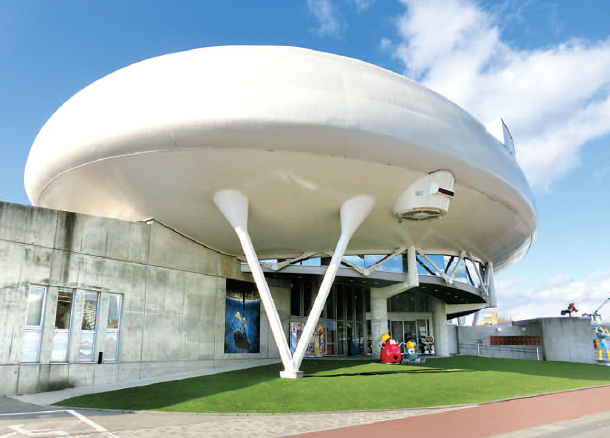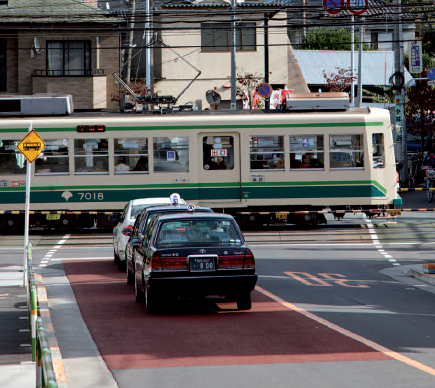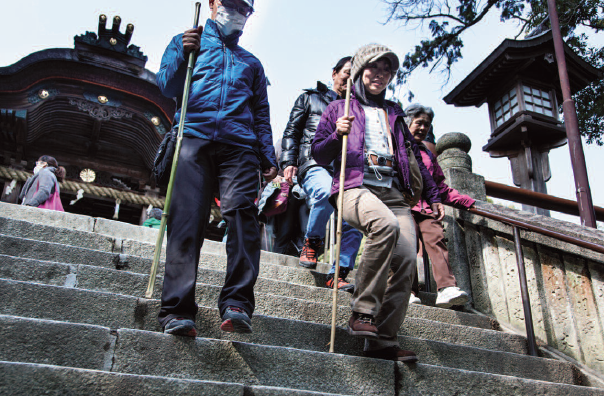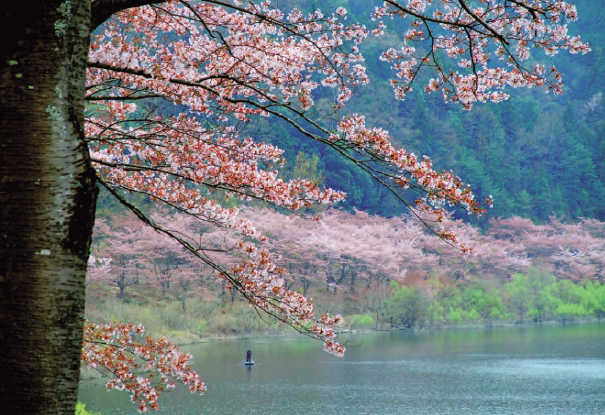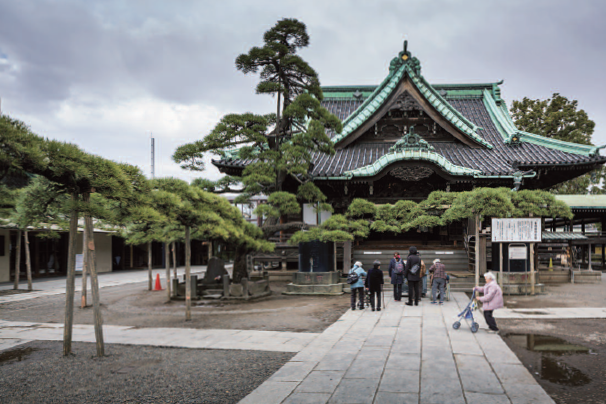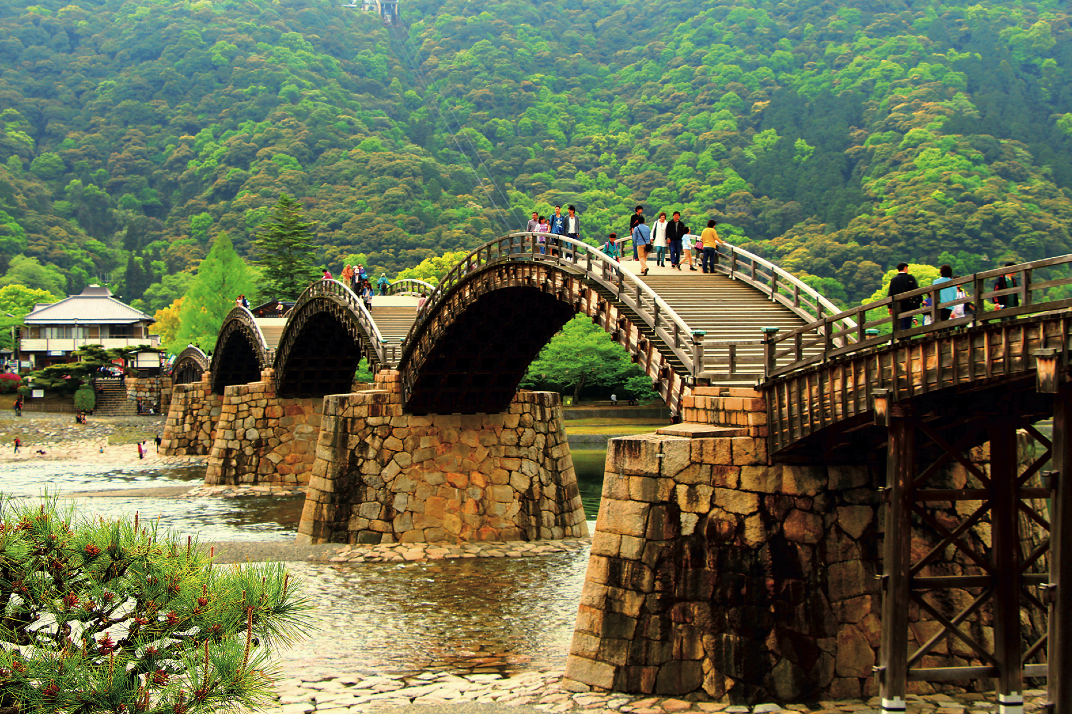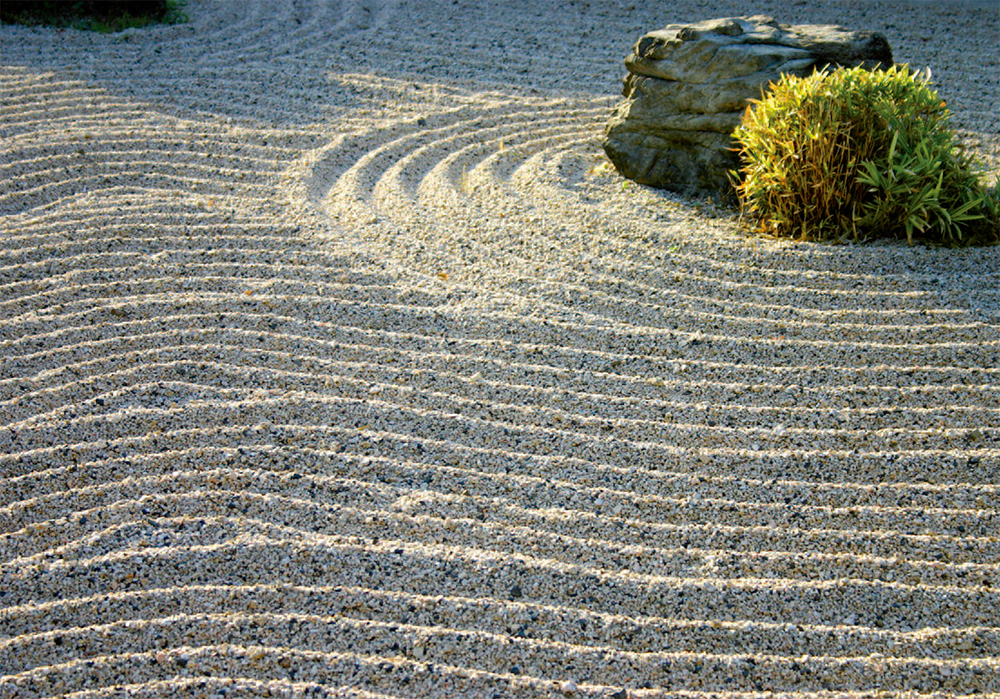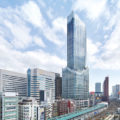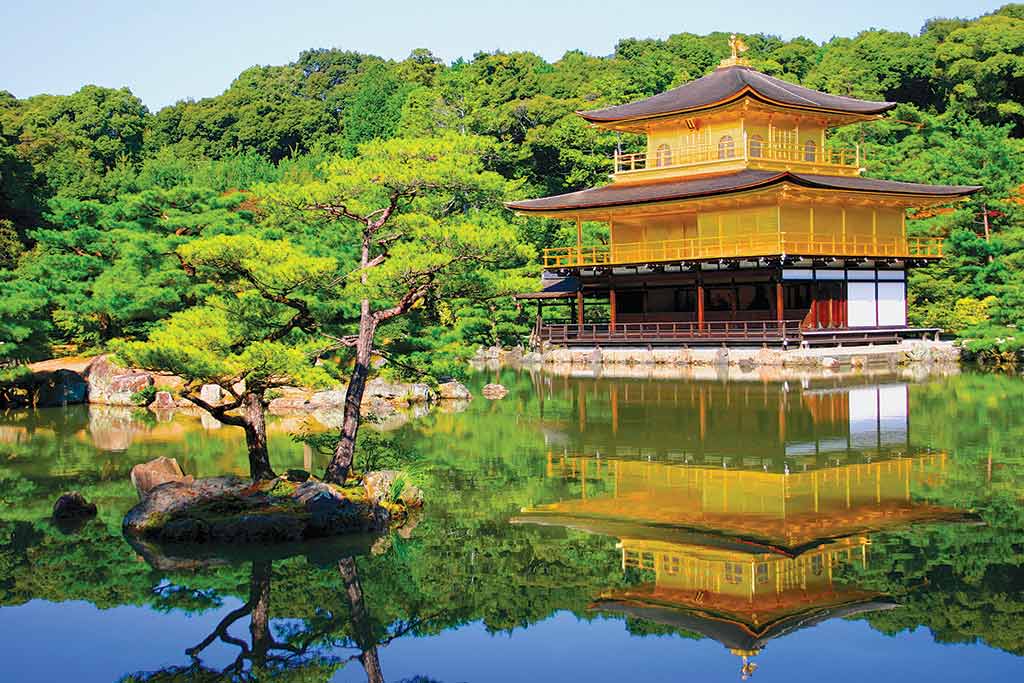
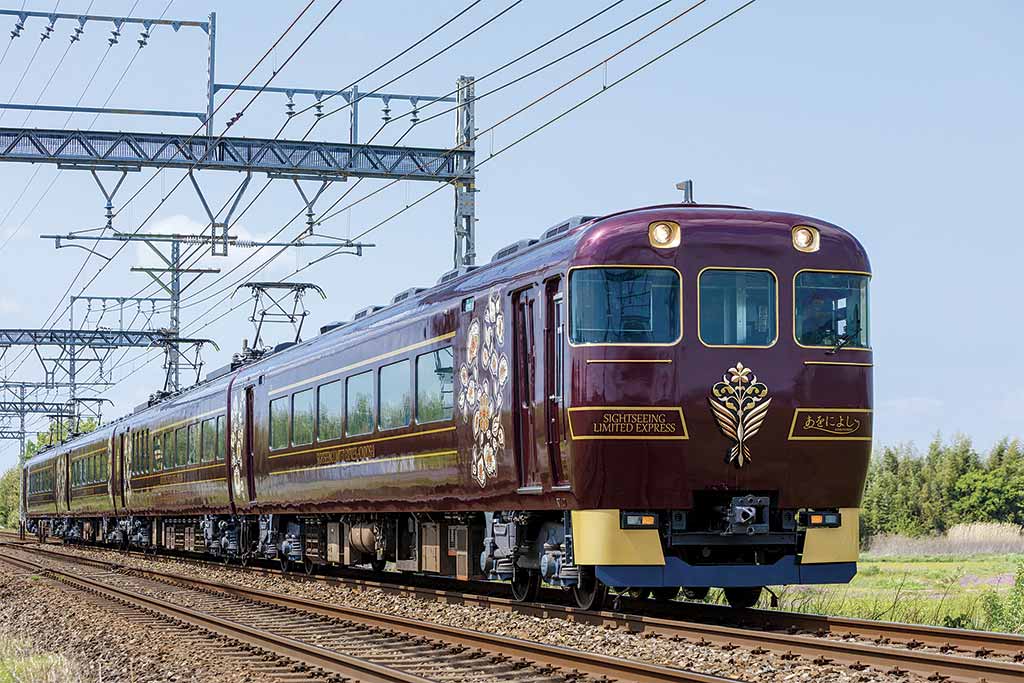
/ Kintetsu Railway Company
Travelling between Osaka, Nara and Kyoto, this new cruise train combines comfort and history.
Japan is a train lover’s delight. The choice of journeys is astonishing, from the romantic beauty of the mountain-crossing Tadami Line in Tohoku, or the coast-hugging Setouchi Marine View train from Hiroshima to Onomichi, to the mighty nation-spanning bullet train.
Recent years have also witnessed a proliferation of luxury sightseeing trains, like highclass hotels on rails. From the futuristic champagne- gold carriages of the Shiki-Shima of Tohoku and Hokkaido to the Olde Worlde elegance of the Seven Stars of Kyushu, Japan’s luxury trains transport you through spectacular scenery while pampering you with fabulous cuisine and luxurious amenities. In Japan, trains are not just a quick way of getting from A to B. They are also an irresistible opportunity to create a thrilling new experience. Like T. S. Eliot said, “the journey, not the arrival, matters”.
The latest addition to the luxury trains is the Aoniyoshi Sightseeing Limited Express (www. kintetsu.co.jp/foreign/english/aoniyoshi/). Inaugurated on 29th April 2022, the Aoniyoshi runs between Osaka, Nara and Kyoto, the three major cities of the Kansai region.
For many visitors, Osaka is not just the starting point of this train journey, it is their first glimpse of Japan after arriving at Kansai International, the airport built on a man-made rectangular island reclaimed from the waters of Osaka Bay. It is Japan’s second-largest city, famous for its dazzling modern architecture, bustling nightlife and scrumptious street-food scene, as well as its historic castle.
Awaiting the arrival of the Aoniyoshi on the platform of Osaka Namba station, you gasp at the regal elegance of the train’s four purple carriages as it glides in beside you. “Purple was considered a noble colour even in the Tenpyo Era (729-749), so it was chosen to create a sense of luxury,” explains Sugiyama Masaki, publicist at Kintetsu Railway Co., which operates the train. The gold crest on the front of the train represents a hanakuidori, a mythological bird considered a harbinger of happy times. Along the sides, floral motifs swirl over the purple background.
The word Aoniyoshi is a poetical name for Nara, mentioned way back in the Man’yoshu, the oldest collection of Japanese poetry, published in 759. The name was chosen to “evoke the spectacular beauty of the Heijo Palace in Nara,” says Sugiyama.
The Aoniyoshi’s four 12200 series carriages originally appeared in 1969, when they were known as the New Snack Car. Queen Elizabeth II travelled on this train from Kyoto to Ise in 1975, the first time a British monarch had visited Japan. The New Snack Car train was also used by Emperor Hirohito and his family on their visits to both Ise Shrine and Kashihara-jingu Shrine in Kashihara, Nara Prefecture. The carriages have been given a complete makeover for their new role.
Such a regal ride befits the region the train travels through. For this is Japan’s heartland, historically known as the Kinki region. Though the word Kinki is often replaced by Kansai now to avoid misunderstandings for English-speaking visitors, Kinki is the cradle of Japan, the birthplace of the country and its culture as we know it today.
Just thirty minutes after leaving Osaka, the Aoniyoshi arrives in Nara, the city where it all began 1,300 years ago. Back then, Nara (or Heijo-kyo as it was then known) was Japan’s first true city, and capital of the country from 710-784. During this time, known as the Nara Period, Japan became a unified state, instead of a collection of clans.
Though Nara was the capital for just 74 years, its legacy is magnificent. It boasts 8 UNESCO World Heritage Sites, collectively known as Historic Monuments of Ancient Nara. They comprise five Buddhist temples, one Shinto shrine, a palace and a primeval forest. The buildings date from the Nara Period or even earlier. They include Japan’s oldest wooden structure (Horyu-ji Temple) and Japan’s earliest Buddhist temple (Gango-ji Temple). Todai-ji Temple is the world’s largest-ever wooden structure and home to the world’s largest bronze Buddha, which is some 18 metres tall.
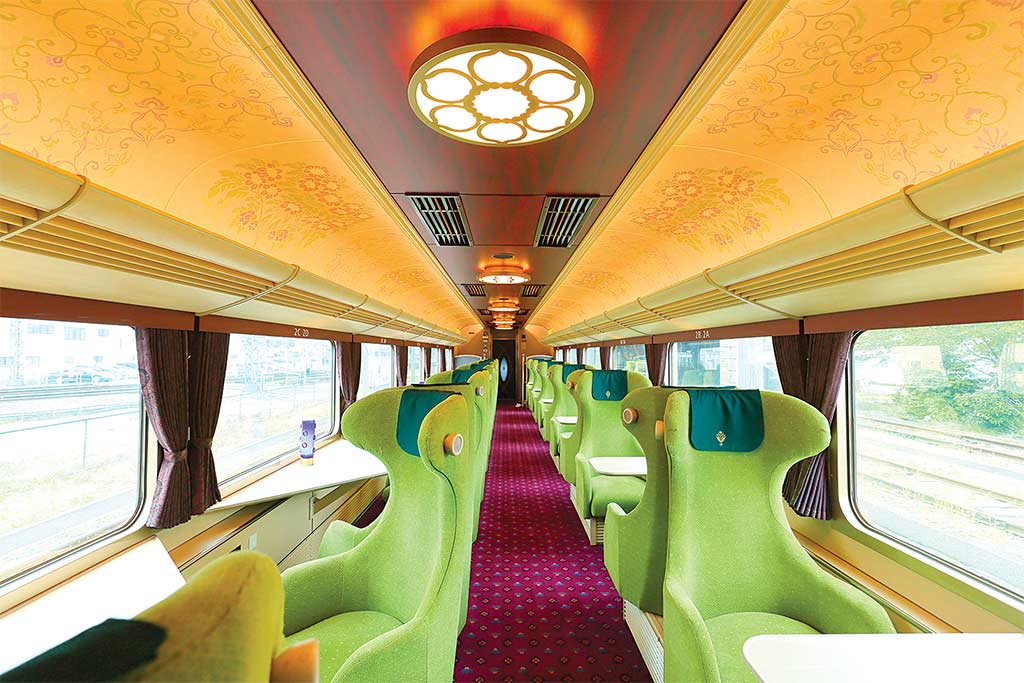
/ Kintetsu Railway Company
The ancient Shinto shrine Kasuga-taisha is famous for its huge park where semi-tame deer roam free. Legend has it that when the powerful Fujiwara clan invited an important deity to Nara, the deity arrived riding a deer. Since then, the deer have been considered sacred and permitted to come and go as they please.
The ancient splendour of Nara’s imperial past inspired the Aoniyoshi’s design. “We want passengers to feel as if they are travelling in the ancient capital of Nara from the moment they get on the train,” says Sugiyama. “The interior is designed to evoke the image of ‘Harmony’ as the main theme of the train. Tenpyo Era patterns, such as those found in the treasures of Shosoin Repository (the Treasure House of Todai-ji Temple, dating back to 756) are scattered throughout the train.” Indeed, the walls, carpeting and even the lights are all decorated with gorgeous patterns of birds and flowers, associated with Nara’s heyday as a capital city.
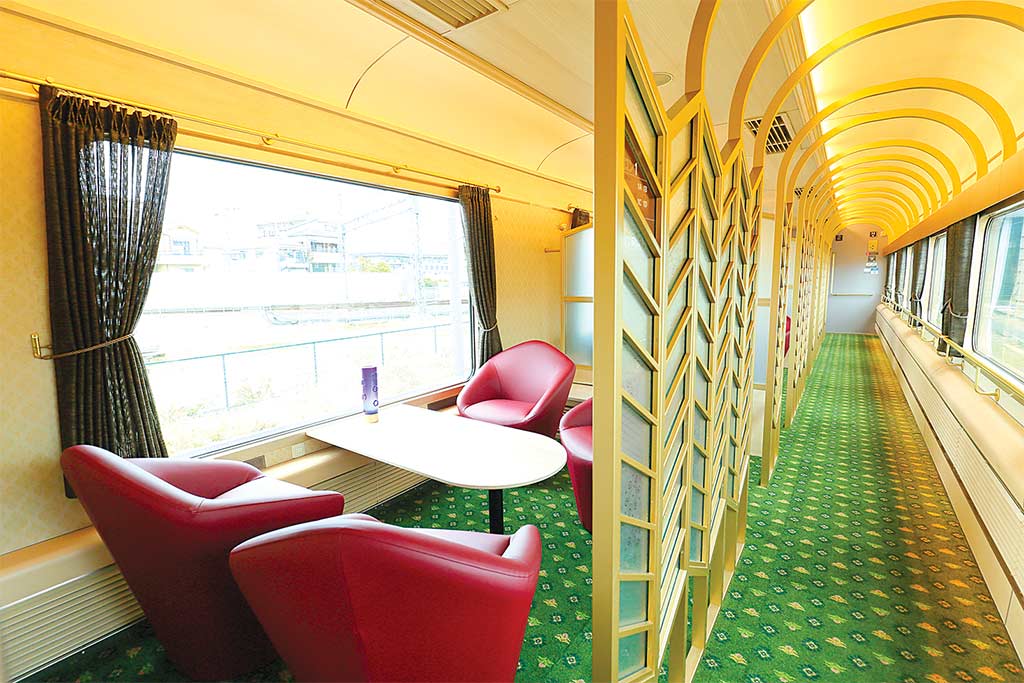
/ Kintetsu Railway Company
The Nara Period was a time when Buddhism flourished in all spheres of life, producing not only grand temples but also some of Japan’s finest Buddhist-inspired art, sculpture and monuments, most famously the Great Buddha, the colossal bronze statue at Todai-ji.
This statue is even present on the Great Buddha Pudding, a custard-like dessert on sale at the Aoniyoshi’s sales counter in Car 2. The jar bears a cute picture of the Great Buddha, along with the message “I wish you are always smiling”. You can also purchase typical Nara products like pure apple and orange juices, craft beers, and a butter cake in a purple box matching the colour of the train. Some of these products are only available on the train. The sales counter’s design, and the decor of the surrounding walls, is also inspired by objects from Shosoin Repository.

In Cars 1, 3 and 4 the seats are arranged in two rows of single seats. So you need not worry about who’s going to sit next to you – there is no seat next to you. On one side the seats are positioned facing towards the huge picture window rather than straight ahead, so you can watch Japan scrolling past as you relax. On the other side the seats face each other in twos, ideal for couples. On the table, a tubular light casts a soothing blue glow.
Car 2 has salon seats in groups of four around a table. They are separated from the aisle by partitions, capped with golden archways “to create a sense of luxury and privacy”.
In Car 4 there is even a library space with books about the journey, which passengers can browse while chilling out on the comfy sofa. And if you are worried about Covid, all surfaces have an anti-bacterial coating to reduce the risk of infection.
Free wi-fi is available throughout the train, and the toilets are of the latest hi-tech computerised variety, one of Japan’s techno delights. “We believe the Aoniyoshi will meet people’s post-Covid travel needs,” says Sugiyama.
Around 90 minutes out of Osaka your luxury journey comes to an end, as the purple ensemble pulls into Kyoto, drawing stares from all those on the platform awaiting their workaday trains. Your ride may be over, but the magic continues as you step out into the streets of Kyoto, Imperial capital of Japan for over 1,000 years (794-1868), with a staggering 17 UNESCO sites, sublime temples and gardens, exquisite tearooms, geishas and historic inns.
So on this occasion, T. S. Eliot was wrong. Of course, the journey matters immensely. But on the Aoniyoshi Express, encompassing the ultra-modern marvels of Osaka, the ancient magnificence of Nara and the timeless beauty of Kyoto, the arrival is also of huge significance. In fact, journey and arrival blend into one, forming an unforgettable odyssey spanning 1,300 years of history and culture.
Steve John Powell
& Angeles Marin Cabello

